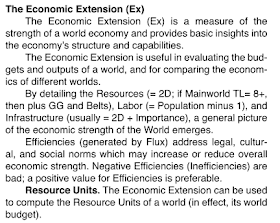Most of you know that I and several confederates savaged the Traveller5 rules last year. Perhaps some of you (I'm looking at you, Faoladh) felt I was being unfair in my assessment of it. At this point, I believe I wasn't harsh enough, and will explain how I came to this conclusion.
T5 introduces the concept of Extensions for planetary systems. Those Extensions are listed as Importance, Economic, and Cultural. A picture is included for the Kinorb system from The Traveller Map as an example of how they are used. (and that's why I am ranting about T5 again; I use the Traveller Map quite a lot in my game, and when I saw these odd numbers crop up I needed to know what they meant.)
I will explain these extensions, using the definitions within the game itself, and you can actually see the point where this data stops being useful and is simply an exercise in mathematical masturbation.
This is an example of a useful bit of data. It explains what the extension is and what the numbers mean. You have to read eight pages ahead to find out how to calculate it, but it's an easy case of "+1 if this, -1 if that"; for example, a Starport of class A or B merits a +1, and Starports of D or worse earn a -1. Add up the values, and if it's 4 or more, it's an important world. That's a good thing to know both data-wise and as background information for role-playing, aka "fluff". I can use this extension, and therefore I like it.
Oh-kay then. I'm not really sure why I'd need to calculate this (and yes, there are calculations involved, this is T5 after all); between Importance and various trade codes (rich, industrial, hi-tech, etc) I can probably figure out if this planet is an economic powerhouse or not, which is really all I'd need for a typical game of Traveller. Maybe I'd need this if the PCs were playing planetary rulers and the planet was theirs to administer (in which case it's a Traveller-themed version of Birthright, but hey, I wrote a game where you can play pre-pubescent talking ponies, so who am I to judge?), but in general I don't need to know (after calculating) the numbers for Resources, Labor, Infrastructure and Efficiency, and then multiply those to get its Resource Units -- in other words, its budget.
And that's all it says on p 427, the same page as the other entries I'm quoting. That's literally all it says about culture. Full stop.
Eight pages later, you get a bit more detail:
There's quite literally nothing further said about it. Not in the main book and not in the errata. Can you see what's missing?
Let's look at the Cx entry for Kinorb again:
What in God's name does any of this MEAN? There's no explanation anywhere in the book. Is a 6 in Symbols a good thing or a bad thing? Is this culture very homogeneous, or is it very non-homogeneous? And while I see the lowest bound is a 1, what's the high end?
This tells me NOTHING. What's worse is that this is information I could really use: Traveller, at least the way I play it, is about voyaging to exotic locations and getting into trouble with the local inhabitants. Knowing if this is a planet full of superstitious racists is critical, gameable data.
I distinctly get the feeling I am being trolled.
Well done, Marc Miller. I mean it; golf applause all round. You can micromanage the GDP of a planet, but you can't be bothered to tell me anything useful about the people who live there. You've actually managed to transcend George Lucas and have become the RPG publishing equivalent of a cocktease.







No comments:
Post a Comment